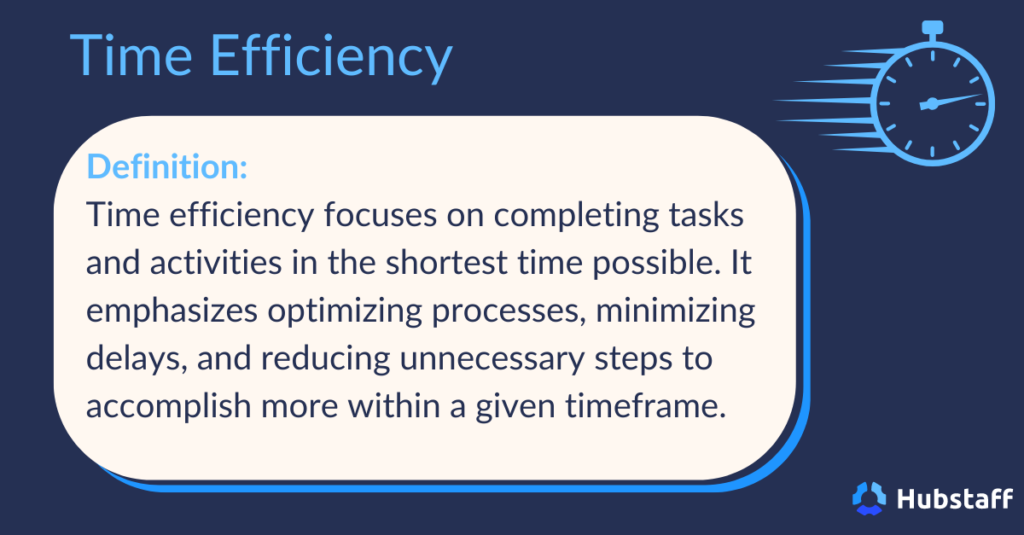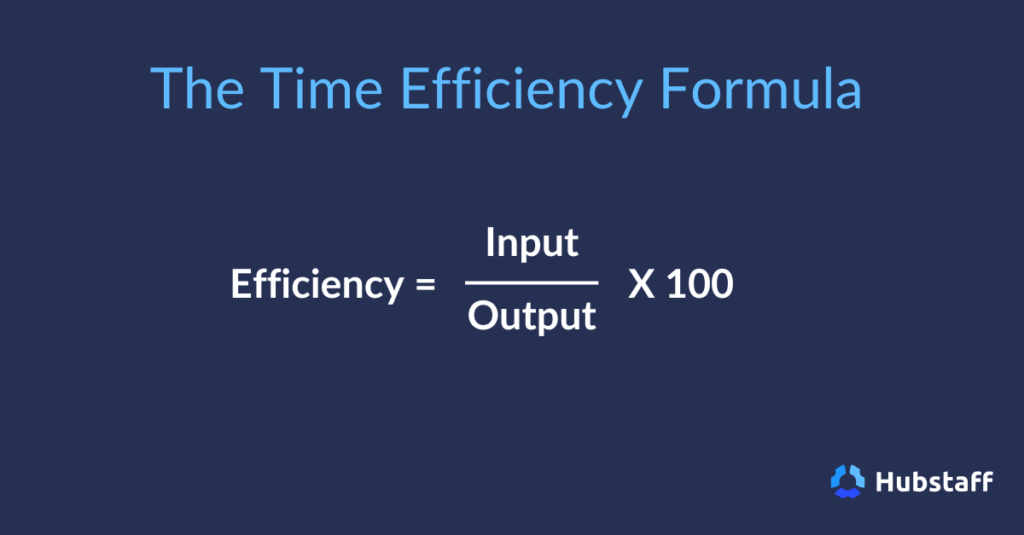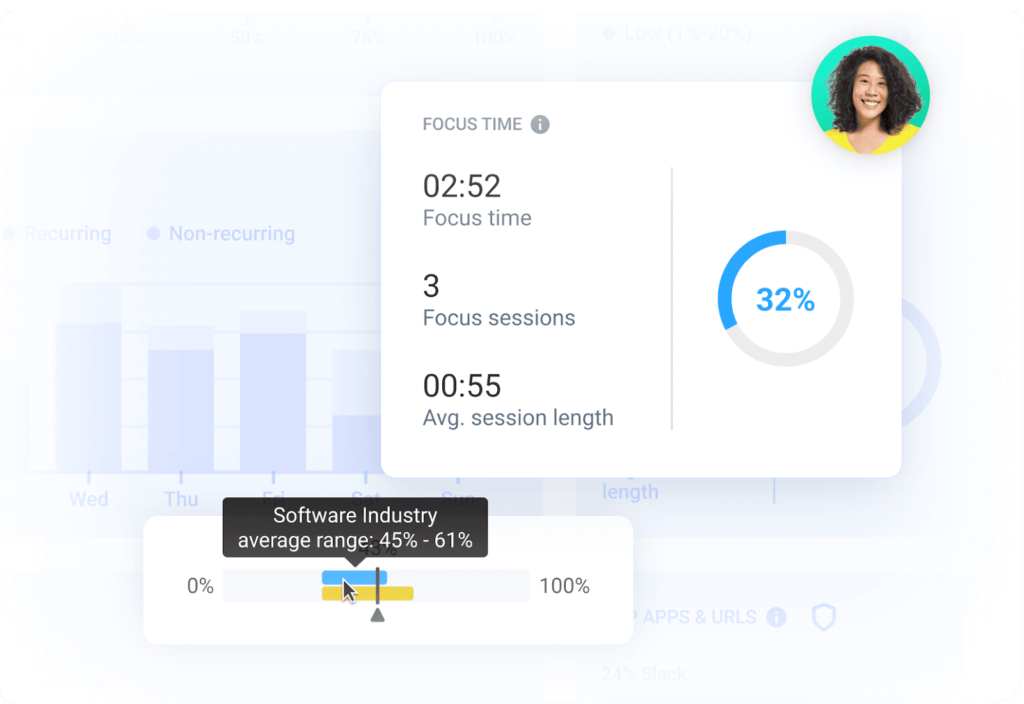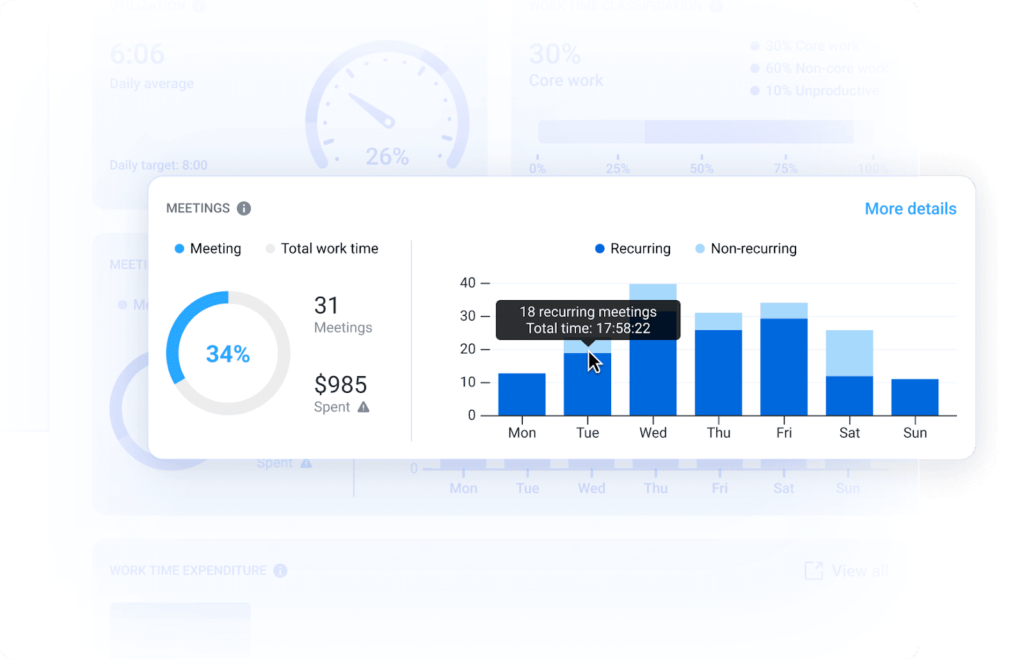At Hubstaff, we’re obsessed with the intersection of time and productivity. The words “time efficiency” and “productivity” are thrown around too casually at times, but understanding how to be productive and use your time efficiently can’t be overstated.
I’ve been on a productivity kick this year, exploring time management strategies like the Pickle Jar Theory and the Pomodoro Method. In this article, I’ll explore real-world examples of time efficiency and techniques we can all learn from.
A time efficiency formula is the key to calculating your efficiency. And, of course, once you determine how to measure your efficiency, the next step is to increase it. That’s where we come in. We’re experts in time management who thrive on helping others find the tools they need to improve efficiency.
How we define these terms is critical to understand before we tackle how to use time efficiently. Let’s start things out by coming to a common understanding of how we define “efficiency.”
Boost your team’s efficiency with Hubstaff's productivity tools
What is time efficiency?
Time efficiency focuses on completing tasks and activities in the shortest time possible and with the least waste. It emphasizes optimizing processes, minimizing distractions, and reducing unnecessary steps to accomplish more within a given timeframe.

Time efficiency vs. time effectiveness
Time efficiency and effectiveness are terms we often use synonymously — but they’re not the same by any means. Here’s a quick overview of how each phrase connects to achieving your goals.
- Efficiency is about completing tasks quickly and eliminating unnecessary costs.
- Effectiveness is about setting goals and achieving meaningful results.
Both concepts are critical to managing time wisely and increasing productivity. Speaking of productivity, let’s quickly clarify where that falls in this spectrum.
Efficiency vs. productivity
These two terms are often used interchangeably. But as a business owner, if you fail to understand the difference between these two ideas, you’ll struggle to set realistic goals for your team.
- Efficiency: Efficiency is about delivering outputs with as little wasted input as possible.
- Productivity: Productivity measures the time it takes to achieve the desired outputs.
I could go on and on about efficiency and productivity, and in fact, I have. If you’re interested, you can also check out this blog post for more about my take on productivity vs. efficiency.
The time efficiency formula

As a data-driven person, I wanted to be able to calculate my efficiency in a standardized way. Luckily, there is a formula that does just that.
The time efficiency formula is input divided by output times 100.
When calculating your efficiency, the first step is determining your input and output.
- Input. Often, the input is the time or energy spent on a task.
- Output. Output differs based on the work you’re doing. Some businesses consider output as the number of products created, words written, or sales made.
Using the formula above, you’ll get a percentage or score that represents how efficiently you complete the process in question. This is just one way to approach measuring time efficiency, and the formula can also be adjusted based on the unique goals and metrics that matter for your situation.
Time efficiency formula example
Let’s look at a few examples of this formula in the real world. I will use my workflow for this week as an example.
This week, I am working on two different articles. In Scenario A, I spend eight hours writing an article, and the resulting content is comprehensive and well-researched. In Scenario B, I spent less time, but the resulting article is less detailed.
Scenario A:
Time spent (input): 8 hours (480 minutes)
Work produced (output): 1500 words
Formula: (480 / 1500) × 100 = 32%
Scenario B:
Time spent (input): 6 hours (360 minutes)
Work produced (output): 1000 words
Formula: (360 / 1000) × 100 = 36%
As you can see, Scenario B resulted in a higher time efficiency score. More output was produced with less input than Scenario A.
Of course, there are always intricacies to consider in these calculations. If Scenario A results in a more comprehensive and valuable output, its actual value might be more than Scenario B’s, even though the time efficiency score is lower.
For instance, the content I wrote in example A could be:
- More thoroughly researched
- Centered around a keyword that is more likely to convert
- More image heavy
- Deemed a more important task by a manager or superior
Efficiency, like any metric, often needs a little context around it.
Strategies to maximize time efficiency
What does a time-efficient person look like? Often, we consider someone to be time-efficient if they produce results swiftly and don’t waste resources. Another cornerstone of a time-efficient person is a willingness to try new strategies that improve efficiency.
Here are our favorite productivity techniques:
- Pomodoro technique. This technique enhances efficiency and productivity by splitting work into intervals, around 25 minutes, separated by quick breaks. The structure of this method allows you to devote focused time to work and allow yourself to relax and reset your mental health during breaks.
- Time blocking. With time blocking, you group comparable tasks and assign them to time blocks. Time blocking minimizes context switching and improves focus.
- The Pickle Jar Method. Using this theory, you identify and prioritize tasks based on urgency and importance. The idea is to focus on 2-3 high-priority items daily to ensure critical work is completed first, then fill in your extra time with lower-priority work.
- Cut down on meetings. By removing unnecessary meetings, companies can create a more efficient work atmosphere where employees have uninterrupted focus time for deep work. At Hubstaff, we have a weekly no-meeting day. We’ll talk more about this idea later.
- Use technology to automate tasks. Finding the right tools can help you automate repetitive or time-consuming tasks. Automation can also free up time for more complicated and creative work. Optimizing your tech stack is the easiest way to increase your efficiency.
Leveraging tools to measure and enhance efficiency
To leverage tools for measuring and improving efficiency, you should embrace a suite of productivity and project management tools tailored to your workflow.
- Time tracking software. Businesses can use time tracking apps to measure how long it takes to complete a task, identify areas for improvement, and optimize time management.
- Task management tools. Teams can implement project management tools to streamline collaboration, visualize work differently, and track progress toward goals.
- Productivity measurement tools. Productivity measurement doesn’t have to be done manually. Productivity tools can help you track and view your team’s productivity in one dashboard.

- Chrome add-ons. Don’t sleep on Chrome productivity add-ons — they are my favorite way to increase efficiency. I rounded up my favorite Chrome productivity tools. Here are my top three:
- Hubstaff. Hubstaff’s Chrome time tracker is a time tracking and productivity app that’s a great way to track time on web-based work. Obviously, we had to plug our add-on, but I really do use this daily to track my time, and it’s so easy to use.
- Grammarly. Grammarly is a grammar checker that you can add to Chrome to inspect your writing for spelling, grammar, and punctuation issues.
- Forest. Forest is a productivity add-on that limits time spent on time-wasting websites. With Forest, you can access a visual manifestation of your work on a project.
- Hubstaff. Hubstaff’s Chrome time tracker is a time tracking and productivity app that’s a great way to track time on web-based work. Obviously, we had to plug our add-on, but I really do use this daily to track my time, and it’s so easy to use.
Case studies in embracing time efficient policies
Let’s explore how these tools, strategies, and methods look in the real world. These examples from actual companies that employed some of the techniques we’ve discussed above can inspire you to start your time efficiency journey.
Anequim uses technology to automate their work
Anequim’s remote team of 1000 needed a competitive edge, so they decided to automate their workforce management with Hubstaff. Anequim is the perfect example of how businesses can use technology to save time and money.
Hubstaff’s workforce management software enables Anequim’s remote team to save hours each week on time tracking and payroll. Hubstaff allows Anequim to streamline all payroll and HR processes. Anequim is one of our newer customers yet, they’ve already seen a 5% increase in productivity from automating PTO with Hubstaff.
Shopify says no to meetings
Shopify made headlines in 2023 by announcing they canceled all recurring meetings with more than two people. Their policy created a “no-meeting Wednesday” rule and limited large (50+) meetings to a six-hour window on Thursdays.
By removing frequent meetings with more than two participants, the company gained back 322,000 hours — that’s a lot of added hours to get work done. Reducing meetings minimizes disruptions, enabling employees to focus on work without constant interruptions.
Hubstaff Insights can help you identify and reduce unnecessary meetings by tracking how much time your team spends in meetings compared to their total work hours.

Next step: Combine these strategies to become more time-efficient
Time management skills are the gift that keeps on giving, helping you accomplish essential tasks and tackle your to-do list. Use these tips to optimize your tech stack, employ time efficiency productivity hacks, and handle more complex tasks.
Our challenge to you? Commit to finding a productivity app or trying out a new strategy today. You might be amazed at how much it impacts your efficiency.
Most popular
The Critical Role of Employee Monitoring and Workplace Security
Why do we need employee monitoring and workplace security? Companies had to adapt fast when the world shifted to remote work...
15 Ways to Use AI in the Workforce
Whether through AI-powered project management, strategic planning, or simply automating simple admin work, we’ve seen a dramatic...
The AI Productivity Panel: Lessons From Leaders on What’s Working (and What’s Not)
When I moderated this AI productivity panel, I expected a solid conversation. What I didn’t expect was the flood of real-world i...
Employee Performance Dashboards: Templates, Tools, and Best Practices
Keeping track of how your team’s really doing can be tricky. Spreadsheets pile up, one-on-ones only tell part of the story, and...



![How to Use Time Blocking to Make 2024 Your Most Productive Year Ever [Free Template]](https://hubstaff.com/blog/wp-content/uploads/2018/12/time-blocking@2x-780x390.png)
